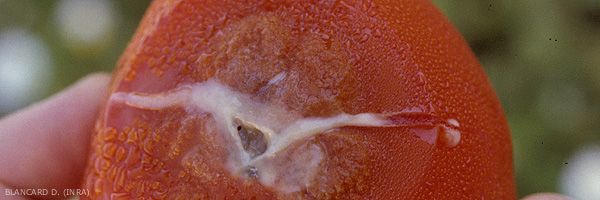
Bacteria with deliquescent rots on fruits
( bacterial soft rot )
( bacterial soft rot )
The bacteria rots deliquescent * on tomato fruit are essentially involves Pectobacterium spp. ( eg Erwinia spp. ); they also affect the Stems . They are responsible for large, fast-growing, foul-smelling, sometimes very damaging wet lesions. The most aggressive is certainly P. carotovorum subsp. carotovorum and, to a lesser extent, P. chrysanthemi , P. carotovorum subsp . atrosepticum , responsible for the potato blackleg, has been isolated from tomato. These bacteria are fairly widespread in many production areas around the world (see also the sheet Pseudomonas corrugata fact ).
- Symptoms
These bacteria cause small, moist, dark lesions, appearing from various wounds and scars and spreading rapidly above and below the surface . Eventually, milky bacterial exudates can be observed at the points of epidermal rupture (Figure 1). Tissues liquefy quickly, and gas bubbles are sometimes seen. These symptoms can occur both during cultivation and after harvest, during storage. Note that they can also over-contaminate lesions caused by other pathogenic microorganisms.
* Some of them are relatively confidential and do not pose a significant threat to tomato production. This is particularly true of certain pectinolytic strain Pseudomonas fluorescens causing rot less rapidly changing as the Pectobacterium ( Erwinia spp.) It is the same for a few Bacillus , the bacteria "lactic" Gram, and Leuconostoc mesenteroides subsp. mesenteroides , occasionally causing some damage.





